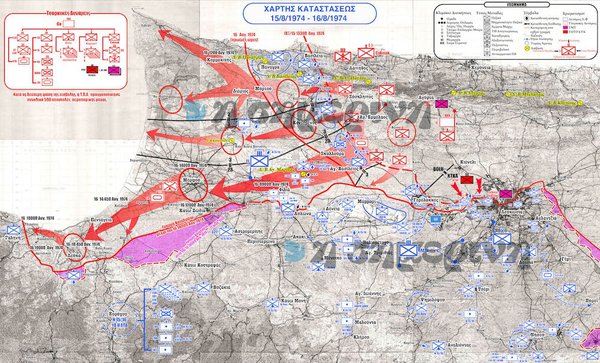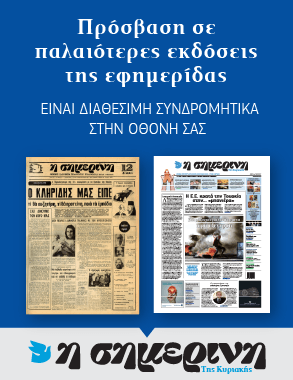How the Frontline Collapsed During Attila II - Division Formed After the Event and the Orders of the National Guard General Staff
Karamanlis’ “Due to Distance” and the Federation, Which Was Unacceptable in Geneva but Is Today the Flag of a “Solution” - The Multi-Regional and the Expansion of Attila Across Cyprus Through the Güneş Plan
On August 14, 1974, the Second Attila began, which was completed on the 16th of the month with the occupation of approximately 37% of the Republic of Cyprus. The frontline had collapsed from the morning of the 14th, causing a domino effect of disorderly retreats. Since then, a series of questions have arisen about what happened, both on the battlefield and diplomatically.
Negotiations and the Exploitation of Time
The Turks had used:
- • The ceasefire and the Geneva talks to gain time and complete the landing and deployment of an Army Corps of 40,000 troops, tanks, artillery, mechanized units, and special forces. Thus, they had achieved overwhelming superiority within the 17% of territory they had already captured and were preparing further offensive actions based on three axes:
- • To the east (Karpasia – Famagusta)
- • To the west (Morphou to Lefka)
- • To the center, namely toward Nicosia.
- • The disorganization of the National Guard, which lacked sufficient anti-tank weapons, had not prepared the necessary defensive organizations, and received no external assistance from Greece, apart from the forces of the 1st Commando Squadron from Maleme, Crete, during Operation “Victory,” and ammunition delivered by two ships, Evangelos and Elli, on July 31 and August 1. However, heavy weaponry was not sent, particularly anti-tank weapons, which were absolutely necessary to repel the new Turkish offensive.

This map shows the disposition of Turkish forces and the National Guard on the eastern front and how it broke in the area of Kythrea–Palaiokythro. The arrows illustrate the Turkish maneuvers leading to the capture of Famagusta and Karpasia. In lilac are shown the areas seized by the Turks after the ceasefire on August 16.
The Turkish Settlement Plans and the Counter-Proposal
At dawn on August 14, Attila II began, as the Geneva talks had collapsed. On August 12, the Turks had proposed two partition-based federal settlement plans.
- • One was by Foreign Minister Turan Güneş, which envisaged the Turkish administration retaining the 17% already occupied by Attila’s forces and the creation of Turkish cantons throughout Cyprus with the right of defense by the Turkish army. It was an idea of partition with dispersion of Attila across the island, called a multi-regional federation.
- • The other was the Denktash federation plan, which foresaw two zones, two regions, and two constituent states. This later became the flagship position of the Greek Cypriot side.
In both cases, the territorial element was around 34–36%. These proposals were not accepted because, according to Glafcos Clerides, then Acting President and negotiator, they were unacceptable. Acceptance would have meant legitimizing territory acquired by occupation. If such a discussion had been accepted, it would have amounted to recognizing as lawful the occupying troops and the illegal gains they had achieved.
From the Greek and Greek Cypriot side, a constitutional proposal had been made by Poly Polyviou and Tassos Papadopoulos for a unitary state with a form of Turkish Cypriot autonomy. This was primarily rejected by the British, who stated it was unacceptable, since the Turks would simply refuse it.
Clausewitz, the Division, and Averoff
Since the Turks had superiority on the ground, they applied all the principles of classical realism: either winning by the shadow of their power or by their actual power, given that Greece was absent.
In Athens, the regime had already changed. The Junta had fallen, and at dawn on July 24, Konstantinos Karamanlis arrived in the country to assume power. However, the military, particularly the General Staff, remained in place.
The Greek Prime Minister, from August 3, had requested the formation of a Division for Cyprus. By the 14th, it was not ready. He requested it again, and it was finally prepared—after the event—on August 19.
The view of Defense Minister Evangelos Averoff and the Chiefs of Staff was that sending troops to Cyprus would be futile, not only because of the enemy’s numerical superiority but also due to technical and strategic problems, such as landing space and Turkish air superiority. There was also another factor: the Greco-Turkish war, which Athens did not want, fearing that beyond Cyprus, there was the risk of losing other parts of Greek territory.
Change of Decision on August 10
From August 10, the Turks, as they themselves attest, had altered their final objective. Since they realized what was happening on the battlefield, that the talks would collapse, and that Greece would remain absent, they included Famagusta and the entire Karpasia Peninsula in their planning.
From the afternoon of the 12th to the 13th, the National Guard General Staff understood where things were heading, since in Geneva the deadlock was obvious. Clausewitz would thus come to the forefront, based on his maxim: “War is the continuation of diplomacy by other means.”
The operational instructions from the Hellenic Armed Forces General Staff to the NGGS on August 12–13 stated that in case of hostilities, contact with the enemy should be maintained, and the entrapment of units should be avoided.
Three Phases
The disposition of Turkish forces on the eastern front and the strategic planning were as follows: offensive action with three divisions in the first echelon, namely the 50th Infantry Regiment, the 28th Infantry Division, and the 39th Infantry Division, with the Motorized Brigade “Bora” as reserve, along with a Paratrooper unit.
The offensive action was to be carried out in three phases:
- • Capture of the line from the Klepini Pass, Kythrea, Palaiokythro up to Tymbou, with the aim of breaking the defensive line of the National Guard, with the main effort along the axis of the 39th Division.
- • If this phase succeeded, the Turkish forces would move to the exploitation of the situation, launching a rapid attack to prevent a possible redeployment of the National Guard. This phase envisaged the capture of the line Agios Amvrosios, Marathovouno, Assia, and Arsos.
- • The third phase concerned the capture of the line Lefkoniko, Prasteio, up to Kontea.
The offensive was conducted up to the first phase on three axes, and then on two:
- • From the north, along the coast, the 50th Regiment of the amphibious force “Çakmak” acted, which had been involved in the initial landing stages.
- • To the south, the 28th Division advanced.
- • In the center, the 39th Division operated.
As the main reserve, the Turks had the Motorized Brigade “Bora” and a Paratrooper unit, which, after the breach of the defensive line and the capture of the line envisaged by the first phase, undertook the continuation of the offensive in the center, exploiting the results toward the final objectives in coordination with the 28th Division, which was advancing in parallel toward Famagusta.
National Guard Forces and the Breach of the Front
On the other side, the National Guard was deployed from north to south as follows:
- • The 32nd Commando Squadron at Pachyammos
- • The 361st Infantry Battalion at Klepini
- • The 251st Infantry Battalion at Koutsoventis
- • The 305th Infantry Battalion under T. Markos in the Mia Milia area
- • The 399th Infantry Battalion from Mia Milia to Aglantzia and SOPAZ
In the vital area of Kythrea–Palaiokythro were also the 241st and 226th Infantry Battalions, and near the Turkish enclave of Gypsou (Tziaos) the 398th Infantry Battalion.
The National Guard forces had no air support whatsoever and lacked adequate anti-aircraft cover. They had no anti-tank weapons and no mechanized or armored forces, although they could have received direct fire support from the 185th Artillery Battalion at Palaiokythro and other artillery units of general support under the NGGS.
Under these conditions, and with the general Turkish attack launched in the early morning hours with artillery, air force, and tanks, by around 10:40 a breach was created in the frontline between the 399th and 305th Battalions. At 10:55, the NGGS issued an order for the withdrawal of forces to avoid their encirclement and for the redeployment of the forces of the Eastern Sector Command (EAST).
With the breach of the front in the Mia Milia area, the Turks entered a flat corridor, essentially along the highway toward Tymbou and Famagusta, where in reality there was no organized second line of defense.
The National Guard forces acted according to the logic of “every man for himself.” For reasons obviously due to the tragic situation of the NGGS—seeking to disengage as many units as possible—the following circumstances arose:
A) Insufficient artillery fire support for the frontline units. B) The shortage of anti-tank weapons and the inadequate defensive organization in depth, combined with the inherent weaknesses of control, coordination, and organization of a second defensive line, led to the collapse of the front with the known results, facilitating the rapid advance of the enemy. C) The 241st and 226th Battalions, which one might argue could have formed a quasi-second line, were inevitably swept away by the general withdrawal.

This map depicts the Turkish offensive on the western front from August 15 to 16. The attack began the day after the breach of the eastern front, on the morning of August 14, 1974. The Attila Line was finalized, tailored to the federal partition plan of Denktash, as submitted on August 12 in Geneva alongside the Turan Güneş plan, both of which were rejected.
Due to Distance…
By midday on August 14, the Turkish army had captured Kythrea, Palaiokythro, and Tymbou. It became evident that they now controlled the crucial Mia Milia–Kythrea junction and that the road toward Famagusta was open. At the same time, they seized Tymbou airport, reaching the outskirts of Nicosia’s eastern suburbs.
By 5 p.m. on August 14, Chalefka and Agios Amvrosios had been taken along the coast, while on the other axis, Attila had reached as far as Assia. From Athens, not only did no help come, but at around 4 p.m. the Greek Prime Minister stated that Greece could not help Cyprus because it lay far away—the well-known “due to distance.” It was as if he were telling the Turks to advance as far as they wished, essentially to Denktash’s map.
The shortages of the National Guard were not enough. The collapse of the front was not enough. On top of that, from the day of the political transition in Greece until the second phase of Attila, no forces had been sent that could have provided a genuine chance of defense. Then came the statement of the Greek Prime Minister. With it, not only did the first line collapse, but so did the morale of all Cypriots.
Not a division, which was not ready, but even a regiment—had it been sent with heavy weaponry and tanks—the defensive line might have held. Not to mention the possible deployment of Phantom aircraft and the panic that would have gripped the Turkish forces on the one hand, and the enthusiasm it would have created among the National Guard and the Greeks of Cyprus on the other.
With the situation as it unfolded, what happened in the end? That which, according to Clerides, would have been considered unacceptable—namely the Denktash federation proposal in Geneva—subsequently appeared as a necessary evil and a compromise. Gradually, it was described as “reunification,” although it stemmed from a dishonorable military defeat. It never ceased to be of Turkish specifications, since it had been designed since 1956 as a form of partition.
August 12 was not the first time it had been presented as a form of solution. It had been preceded by Ecevit’s proposal of July 18, 1974, to the British.
Famagusta and Orders
On August 15, the Feast of the Virgin Mary, Turkish forces advanced rapidly and captured Lefkoniko with the 39th Division. After taking Assia, the 28th Division advanced toward Vatili and Lysi, reaching as far as the British Bases. On the battlefield, as already mentioned, the Motorized Brigade “Bora” and Paratroopers had also been deployed. By 11 a.m., the Turks had reached Stylous and Agios Sergios.
That same day, at around 13:00, they captured Trikomo and moved toward Gastria to seize Karpasia, as well as toward Famagusta, which fell without resistance at 18:45.
Concerning Famagusta, there were two orders. The first was issued in the midday hours of August 14 for the withdrawal of the 15th Tactical Formation and several of its units. Subsequently, on the afternoon of August 15, another order was issued for the withdrawal of the remaining forces, effectively abandoning the city without a fight. Tragic circumstances of a chaotic situation.
Central Front (Nicosia)
In parallel with the offensive on the eastern front, the Turks attempted to advance into residential areas on the outskirts of the Green Line in Nicosia. However, the main objective of their offensive was the capture of the area east of the airport: the ELDYK Camp, the Grigoriou School, and the western outskirts of the Kolokasidis junction.
On the central front there were:
- • Three companies of ELDYK (2nd, 4th, and the Headquarters Company) that remained to defend their camp.
- • Forces of the III Higher Command, with the 212th Mobilization Battalion covering the area from the junction of Demokratias Avenue and Grigoris Afxentiou Street, near Diomidis’ grill house in Agios Dometios, up to the camp of the 11th Tactical Formation, east of Nicosia Airport. To the right, since July 20, 1974, the 211th Infantry Battalion was defending, reinforced by the 336th Territorial Battalion, taking over part of the defense sector from Agios Dometios to Ledra Street.
The fighting was fierce until the ceasefire on the 16th. It is evident that the Turks were halted along the entire front line and failed to outflank Nicosia from the west. Significant was the action of the 187th and 184th Field Artillery Battalions, with Russian 100mm guns, which inflicted severe damage on the Turkish forces and contributed to the successful defense by the infantry. Despite having only a few anti-tank weapons, the infantry managed to pin down the Turkish tanks, thwarting their objective.
The Fall of the Western Front
On the western front, the advance began on the 15th of the month. It followed the breach of the eastern front the previous day, where the main Turkish effort had been concentrated.
The first attack on the western front took place at the Agia Marina–Skouriotissa crossing. There, Captain Skarlatos’ battery of the 183rd Field Artillery Battalion fought successfully, together with tank crews using remnants of the National Guard’s armored forces and a Turkish M-47 tank captured by National Guardsmen.
The Turkish forces acted in two phases along three directions:
- • First: Sysklipos, Larnakas Lapithou, Diorios, Kormakitis.
- • Second: Agios Ermolaos, Kalo Chorio–Kapouti, and Sergianochori.
- • Third: Skouriotissa, Agios Vasileios, Filia, Morphou, Pentagia, Lefka, and Limnitis, where their main effort lay.
The central attacking force was the “Bolu” Brigade, whose movements began at 13:30 on August 15. The first defensive line was at Panagra, Myrtou, Kontemenos, and Agios Vasileios. Afterward, the NGGS ordered a limited withdrawal further south and finally a major withdrawal, with concentration of forces around Evrychou for reorganization.
From 3 p.m. on the 15th until late afternoon on the 16th, even after the ceasefire, village after village fell, as well as Morphou. In this way, the Attila Line—or Denktash Line—was drawn on the ground, based on his map for a federal solution. What was originally a partition plan has since become the banner of so-called “reunification.”



